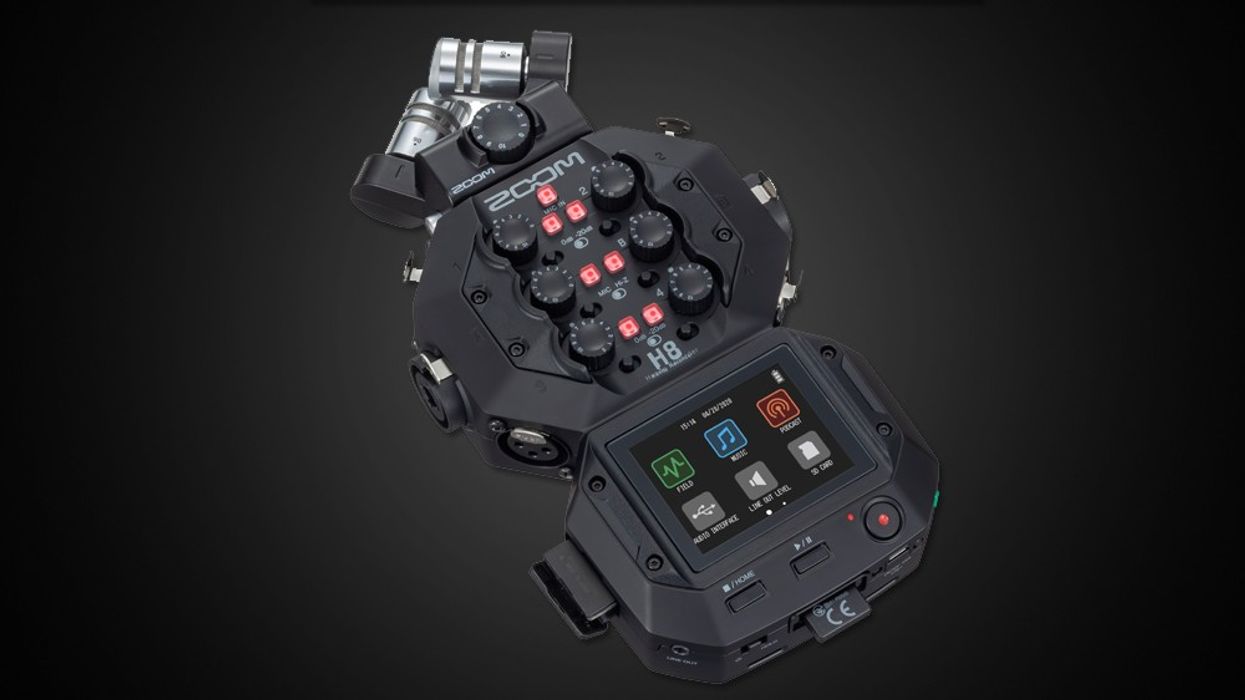The Zoom H8 Audio Recorder Aims To Do It All
The Zoom H8 has a unique and compact design that expands functionality.

The H8 is the latest handheld audio recorder from Zoom. It's a multi-functional device aimed at production sound recordists, podcasters, and musicians.
Simply looking at the uniquely inspired design, you have to wonder how many spider puns could crawl into this post, but when considering the history of the H line and what the H8 is trying to achieve, the fresh take makes sense.
The H4, and eventual H4n, became popular during the Canon EOS 5D and 7D Mark II boom. Filmmakers looking for quality audio at an inexpensive price tag paired the cameras with the Zoom recorders as an external option or pass-through audio. The audio would then be synced in post using programs like Red Giant's Plural Eyes or by hand via slate. There were other players, like Beachtek or JuicedLink, but Zoom had a stranglehold on the market because of its availability and 4-track recording.
While the H4n is still a popular external recorder among creators, the preamps found on DSLR and mirrorless cameras have improved substantially. Cameras now come with manual audio controls and better signal-to-noise ratios, allowing today's vloggers to generally resort to an external microphone that plugs directly into a camera over another device.
But for those outside of vlogging, a separate audio solution is always preferred. The H8 continues that tradition and improves upon the H6. Capable of recording up to 12-tracks simultaneously, its user interface is app-based where creators can switch from a Field, Podcast, or Music app with a touch of a button. Each mode has its own interface and functionality.
The Field app is dedicated to location sound work including foley. It gives access to large meters for every track, and like the H6, you can adjust input type, low-cut, compression, limiter, noise gate, and other key features. The Podcast interface gives access to dedicated sound pads where you can trigger sound effects and music beds. Zoom has included 13 different sounds with the H8, or you can load your own via SD card. The Music app unlocks 12-track recording where you can mix, overdub, and EQ the audio. You can also connect to Zoom's Guitar Lab via USB to further mix the music.
Besides the design, the biggest difference between the H6 and H8 is ease of use. Everything on the H8 has been streamlined for quick use in the field. It features six XLR inputs, two of which are XLR/TRS combo jacks. Each XLR input provides phantom power and has gain control knobs of -20dB. The H8 can record audio up to 24-bit 96kHz in BWAV or MP3 format. It also has auto-record, pre-record, and backup functions as well as low-cut filters, compression, and limiters.
The H8 can be used with Zoom's external microphone capsule system that allows you to insert a microphone on top of the unit. It comes with the XYH-6 capsule that records audio in an XY pattern. The H8 records directly to SD, SDHC, or SDXC cards up to 128GB. Zoom says 4 AA alkaline batteries provide up to 20 hours of power, which is pretty impressive if that figure includes running phantom power on all 6 XLR inputs. It can also be used as a computer interface similar to the H6.
It's important to note that the H8 doesn't record 12 different audio tracks. It has 8 input channels, but with backup recording, it can record 12 tracks simultaneously. So you get 8 tracks with 4 backups.
The H8 also doesn't have the same 32-bit float recording and A/D converters found on the F6. It's clear Zoom wants to keep its F and H line separate, so it's unlikely there will be any crossover any time soon. While most film and television productions record at 24-bit 48 kHz or 48.048 kHz, when 32-bit float recording is combined with A/D converters, it provides a substantial amount of headroom. Audio virtually never clips. It's a great feature to have, especially those starting out learning how to mix and record. It gives you a ton of leeway for scenes that require screaming or have loud helicopters, sound effects, or even music.
Because of its unique design, the H8 might not be the best solution for an audio bag as the XLR inputs wrap completely around the device. If you're a production sound mixer, you might be better off with the H6 or an F series recorder when using an audio bag. However, the H8 seems great for those doing a mix of things from podcast, music, and field recording even if it does seem to favor more on the podcast side. It will be interesting to find out how the preamps compare to the H6 and other Zoom products.
The Zoom H8 is available now for $399. The Zoom H6 costs around $350.













